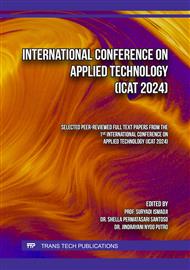p.71
p.85
p.93
p.101
p.111
p.121
p.127
p.141
p.153
Comparison of Fresh Water and Salt Production of Seawater Desalination Using Gas Stoves and Induction Stoves
Abstract:
This study investigates household-scale seawater desalination to address freshwater shortages, particularly in coastal areas or during emergencies. The process involves heating seawater to evaporate it and then condensing the vapor into freshwater. The research compares the efficiency of pure water and salt production from seawater desalination using two heating methods which is gas stoves and induction stoves. Gas stoves which use fossil fuel combustion and induction stoves which use electromagnetic fields to generate heat have different characteristics and efficiencies in the desalination process. After the heating, the seawater then cooling down by using 3 different speed of fan speed.This study evaluates the differences in the amount of pure water and salt produced by these two methods, considering factors such as energy consumption and operational costs. The results of this research are expected to provide useful insights for selecting more efficient and economical heating methods in the seawater desalination process.The results indicate that freshwater production is higher when using an induction stove compared to a gas stove. Freshwater production at low fan speeds yielded 157 g/hour on an induction stove with 600 W power and 147 g/hour on a gas stove with equivalent power of 658.75 W; 168 g/hour on an induction stove with 600 W power and 88 g/hour on a gas stove with equivalent power of 632.92 W; and 153 g/hour on an induction stove with 600 W power and 105 g/hour on a gas stove with equivalent power of 646.58 W. The heating with an induction stove produces more freshwater compared to heating with a gas stove due to its Energy Efficiency, Precise Temperature Control, Heating Speed, Reduced Heat Loss which is better than gas stove.In terms of salt production, both induction and gas stoves produced nearly identical amounts of salt: 34 g/liter on the induction stove and 36 g/liter on the gas stove at low fan speeds; 36 g/liter on the induction stove and 34 g/liter on the gas stove at medium fan speeds; and 34 g/liter on the induction stove and 36 g/liter on the gas stove at high fan speeds. The power required to produce 1 gram of freshwater at low fan speed was 3.57 watts for the induction stove and 7.18 watts for the gas stove; at high fan speed, it needs 3.92 watts for the induction stove and 6.15 watts for the gas stove. Therefore, it can be concluded that the power consumption for the induction stove is significantly lower than that for the gas stove to produce 1 gram of freshwater.
Info:
Periodical:
Pages:
111-120
Citation:
Online since:
February 2025
Authors:
Keywords:
Price:
Сopyright:
© 2025 Trans Tech Publications Ltd. All Rights Reserved
Share:
Citation:


